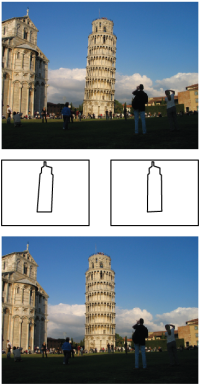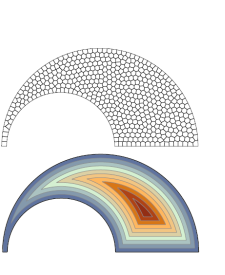Overview
 Interpolating given discrete data with continuous functions in one or more variable is a fundamental problem in diverse fields of sciences and engineering. Barycentric coordinates, which were introduced by Möbius in 1827, still provide perhaps the most convenient way to linearly interpolate data prescribed at the vertices of an n-dimensional simplex. Barycentric interpolation is widely used in computer graphics, whereas such interpolating (basis) functions can also be adopted as trial and test approximations in finite element methods. Starting with the seminal work of Wachspress in 1975, the ideas of barycentric coordinates and barycentric interpolation have been extended in recent years to arbitrary polygons in the plane and general polytopes in higher dimensions, which in turn has led to novel solutions in applications like mesh parametrization, image warping, mesh deformation, and finite/boundary element methods.
Interpolating given discrete data with continuous functions in one or more variable is a fundamental problem in diverse fields of sciences and engineering. Barycentric coordinates, which were introduced by Möbius in 1827, still provide perhaps the most convenient way to linearly interpolate data prescribed at the vertices of an n-dimensional simplex. Barycentric interpolation is widely used in computer graphics, whereas such interpolating (basis) functions can also be adopted as trial and test approximations in finite element methods. Starting with the seminal work of Wachspress in 1975, the ideas of barycentric coordinates and barycentric interpolation have been extended in recent years to arbitrary polygons in the plane and general polytopes in higher dimensions, which in turn has led to novel solutions in applications like mesh parametrization, image warping, mesh deformation, and finite/boundary element methods.
Sponsored by the National Science Foundation, this workshop is intended firstly to provide greater synergy between the two fields so that a broader class of problems and associated solution strategies can be conceived, and secondly to aid in advancing graduate education in a multidisciplinary setting. This workshop provides a forum for the novice as well as the expert to gain a better understanding of the potential use of generalized barycentric coordinates in different areas of science and engineering.
We encourage students and young investigators to attend the workshop and to apply for a travel fellowship (covers registration fees, accommodation, and travel costs). We particularly welcome applications from those under-represented in science and engineering.
 |
TopicsSome of the featured topics in the workshop are:
|

